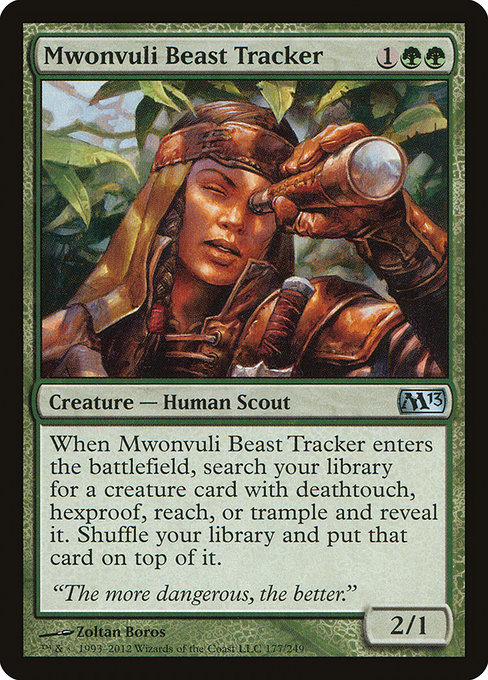
Image courtesy of Scryfall.com
Cultural echoes in jungle art: Mwonvuli Beast Tracker and the path from forest to fantasy
Magic: The Gathering has long invited us to wander into worlds where color palettes, patterns, and environments carry more meaning than a simple backdrop. When you look closely at Mwonvuli Beast Tracker, a green-red-green?—no, green-focused scout with a keen eye—it's impossible not to hear the whisper of dense jungles, drumming rhythms, and the patient wisdom of trackers who know the land as a living map 🧭. This 2012 core-set creature embodies how MTG art and flavor draw from real-world cultural textures to make the hunt feel intimate, tactile, and a little bit primal. The art by Zoltan Boros, with its lush greens, twisting vines, and a hunter-on-the-horizon silhouette, is a case study in translating ecological abundance into a card frame that breathes with life 🔥.
The card’s mana cost—{1}{G}{G}—anchors the color philosophy of growth, community, and symbiosis. Green has always celebrated the wild as a cooperative force: creatures that rely on the land, ecosystems that reward patient planning, and a respect for the food chain’s interconnectedness. In Mwonvuli Beast Tracker, that philosophy rhymes with a mechanic designed to reward curiosity. When this creature ETBs (enters the battlefield), you search your library for a creature card with deathtouch, hexproof, reach, or trample and reveal it before shuffling it back on top. It’s a doorway to synergy, a tiny tutoring effect that invites you to layer threats and protections for the rest of your deck 🧙♂️⚔️.
Look a little closer at the artwork, and you’ll notice the cultural language embedded in the scene. The tracker’s posture, the flora that crowd the frame, and the sense of a living, dangerous ecosystem—all evoke a tapestry of jungle storytelling found in many African and Afro-diasporic art traditions. It’s not about caricature or broad stereotypes; it’s about capturing the mood: a borderless wilderness that hums with energy, where every leaf has a story and every predator a motive. The card’s flavor text—“The more dangerous, the better.”—reads like a hunter’s creed, balancing bravado with respect for the risk and adrenaline that define the hunt. That blend of awe and peril mirrors the way many cultures frame wilderness as both a challenge and a teacher 🎨🎲.
“The more dangerous, the better.” — Mwonvuli Beast Tracker
What does this mean for gameplay and deck-building? In practice, the card rewards you for playing creature-heavy greens, especially those that want to fetch the best tools for the toolbox. The ability to tutor up a creature with deathtouch, reach, or hexproof can shore up a vulnerable board state or set up a winning late game when you’ve unveiled a bevy of threats. Reach helps you control aerial aggression from flying creatures, while hexproof protects the critter you fetch from direct targeting, and deathtouch can tilt combat in your favor when you’ve got a bigger battalion on the board. The synergy feels like a green-green groove that uses the jungle floor as a springboard: you don’t just play big bodies—you curate a curated ecosystem where every piece supports the next 🧙♂️💚.
Collectibility and history also orbit this card. From a collector’s perspective, Mwonvuli Beast Tracker sits in the lower rungs of the rare-to-uncommon spectrum, but its value isn’t purely monetary. It’s a snapshot of an era when core sets experimented with more “jungle-life” sensibilities—art that leaned into exploration, wildlife, and the tactile feel of a world you could almost reach out and touch. The card’s foil availability and non-foil prints show typical gradient pricing, with foils edging upward in certain market windows. For players who love EDH/Commander or casual multi-player formats, the card’s ability to fetch protection-oriented creatures keeps it relevant in a wide swath of green-based archetypes. In other words, it’s not just a pretty picture—it’s a strategic invitation to draft a living forest on the table 🧩.
From a design standpoint, the combination of color identity (green), creature type (Human Scout), and the triggered search effect creates a satisfying recursive loop: you pay a modest mana cost to accelerate toward a protective or offensive creature that can influence combat or blocking in the same turn. The art reinforces that loop. The visual language—dense canopies, vines tightening around the frame, a silent promise of “go deeper”—parallels the in-game need to go deeper into your deck’s library to grab the exact tool you require. It’s a reminder that MTG’s best cards often pair elegant mechanics with an evocative world-building moment, a synergy you can feel in both your play and your imagination 🧙♂️🔥.
And if you’re someone who streams, builds, or brews while chasing the next big creature beat, this card becomes a kind of mascot for the green story: you’re the tracker, the jungle is your arena, and every fetch is a step toward a more cunning strategy. Speaking of setups and aesthetics, a neon-friendly workspace—like the Neon Gaming Mouse Pad 9x7 with stitched edges—can be the perfect companion for long planning sessions, warm-up rounds, and late-night draft marathons. It’s a subtle nod to the same spirit the card embodies: vibrant, durable, and game-ready 🧡🪵.
For readers who love digging into the culture behind the art, this card is a compact case study. The jungle motif, the hunter’s gaze, and the ecological logic of the fetch mechanic all speak to a broader fascination with nature as both a resource and a narrative force. It’s a reminder that MTG’s multiverse isn’t just about spells and numbers—it’s about people, places, and the ways we imagine a world where the wild teaches us to adapt, plan, and celebrate the hunt together 🧭💎.
More from our network
- https://blog.digital-vault.xyz/blog/post/decoding-mtg-rarity-glyphs-your-own-face-mocks-you/
- https://crypto-acolytes.xyz/blog/post/hidden-gems-underrated-minecraft-survival-maps/
- https://blog.digital-vault.xyz/blog/post/karlach-tiefling-spellrager-endgame-power-plays-in-mtg/
- https://blog.digital-vault.xyz/blog/post/brightness-signals-a-hot-stars-true-type-across-2-kiloparsecs/
- https://transparent-paper.shop/blog/post/crafting-logo-mockups-for-standout-brand-presentations/